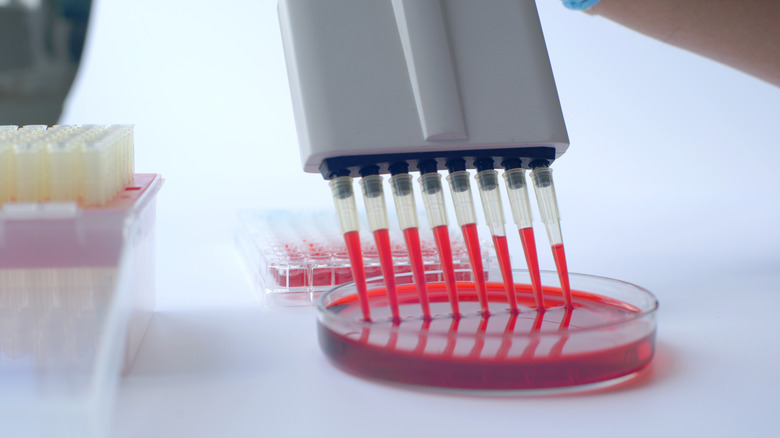What It Means When Your Platelet Count Is High
For many people, blood is a brick-red fluid running through the veins. However, there's so much more to your blood than its color. Blood is made up of four main components: red blood cells, white blood cells, plasma, and platelets (via the American Society of Hematology). Each has its unique characteristics, affording you a quality and healthy life.
Platelets, also known as thrombocytes, are small colorless cell fragments formed in your bone marrow used to control bleeding and fight chronic diseases, per the American Red Cross. To measure the number of platelets in your blood, you'll need a platelet count test (via Medline Plus). According to a 2018 study published in the journal Platelets, the normal range varies by age, sex, and ethnicity. However, the normal platelet count for all adults should be between 150,000 and 450,000 platelets per microliter of blood (per the National Insitute Heart, Lung, and Blood Institute). If the platelet test results are significantly above or below the normal range, it might indicate certain health conditions.
What high platelet levels mean
When the bone marrow produces excessive blood platelets, it's known as thrombocytosis (via Medical News Today). Thrombocytosis is usually grouped into two types: primary and secondary. Primary thrombocytosis, also called essential thrombocythemia, happens when your bone marrow produces too many platelets, per the Cleveland Clinic. The rare genetic disorder develops over time and is linked to a gene mutation called JAK2. According to a 2022 article published in Stat Pearls, the incidence of primary thrombocytosis increases with age, and most patients are between 50 and 60 years old.
Secondary thrombocytosis, also characterized by an above-normal platelet count, is usually caused by an infection, per the Mayo Clinic. According to a Stats Pearls article, secondary thrombocytosis is more common and is seen in about 80% to 90% of those with thrombocytosis cases. Apart from infections, the underlying causes include iron deficiency, asplenia, cancer, or chronic inflammation.
Symptoms of high platelet levels
Platelet levels, especially the primary type, don't usually have symptoms, as explained by Healthline. However, blood clots are normally the first sign of the problem. They can develop anywhere but mostly occur on the feet, hands, or brain. In some severe thrombocytosis cases, blood clots can form in your abdomen, increasing your susceptibility to a heart attack, per the Cleveland Clinic. Fortunately, the location of the blood clot can determine the symptoms you experience, but general symptoms include headaches, lightheadedness, and vision challenges (per Healthline).
Some people with primary thrombocytosis can develop erythromelalgia, which causes pain, swelling, and redness in their hands and feet (via Cleveland Clinic). Others may also experience numbness and tingling. Even though it's less common, some people experience bleeding through the nose, mouth, or stools. However, this usually happens when the count exceeds 1 million platelets per microliter of blood, as per the Mayo Clinic.
Symptoms of secondary thrombocytosis are often caused by continuous conditions, such as anemia (via Johns Hopkins Medicine). In such cases, addressing those conditions can cause platelet levels to decrease. Generally speaking, thrombocytosis can become a life-threatening condition, causing severe complications, such as thrombosis development and hemorrhage, according to a 2019 study published in The Pan African Medical Journal. While there may be no cure, doctors normally prescribe treatment options to help you manage severe symptoms (via National Heart, Lung, and Blood Institute).



